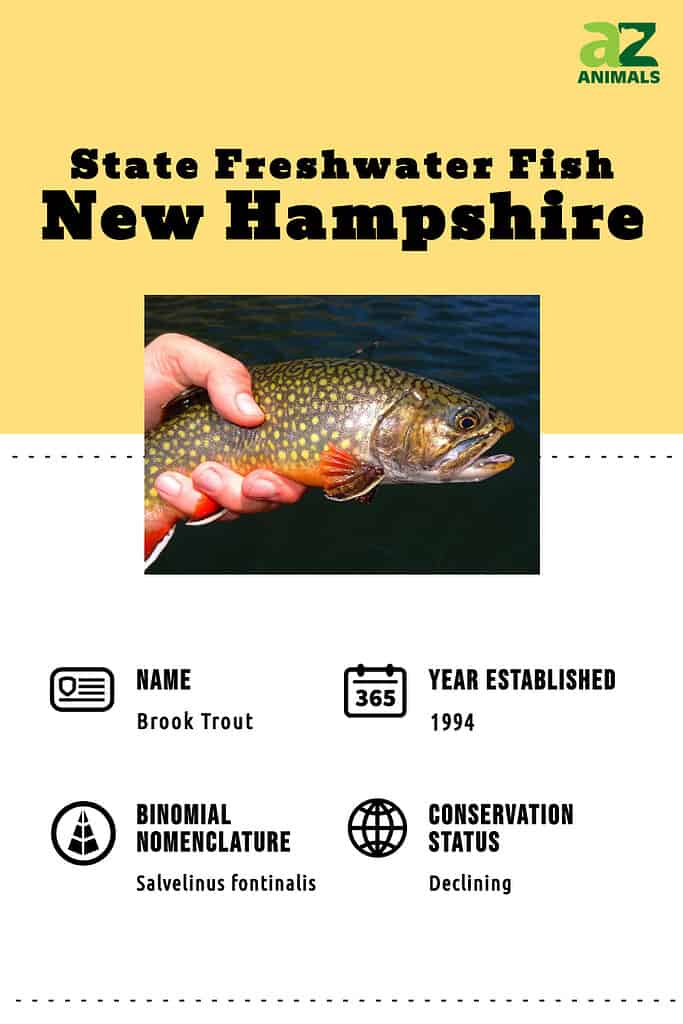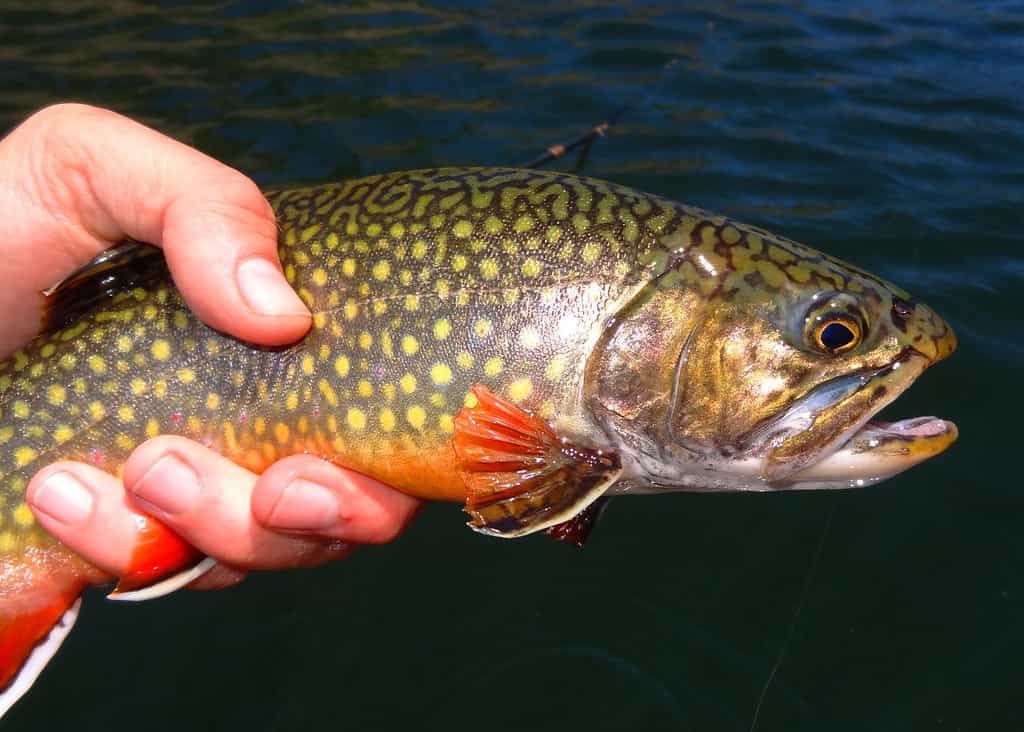
If you’re looking to cast a line in the beautiful state of New Hampshire this summer, you may want to know what fish are swimming beneath the surface. And even more importantly, which one is the official state fish? Look no further than this article for all your fishing needs! We’ll take you on a journey through the waters of New Hampshire and introduce you to its official state fish, as well as where to find them. Get ready for an adventure full of angling excitement!
State Freshwater Fish of New Hampshire

Brook trout are the state freshwater fish of New Hampshire.
©Matt Jeppson/Shutterstock.com
Brook trout, scientifically known as Salvelinus fontinalis, holds the honorable title of being the official state freshwater fish of New Hampshire since 1994. These magnificent fish are native to North America and live in various cold-water habitats such as streams, rivers, lakes, and ponds throughout New Hampshire.
Known for their unique coloration and distinctive markings, brook trout are a sight to behold. Typically ranging from six to ten inches in length on average, these fish have an elongated body with a forked tail that helps them navigate through swift currents effortlessly.
Brook trout are opportunistic feeders and will eat anything from insects to small crustaceans. They rely heavily on their keen sense of sight to catch their prey and can often be spotted lurking near underwater structures or vegetation, waiting for their next meal.
One unique characteristic that sets brook trout apart from other species is their ability to thrive in cold water temperatures. Not only do they prefer it, but they also require it for survival. This makes them particularly sensitive to environmental changes such as pollution or climate change, which can impact their habitat negatively.
Despite facing numerous threats over the years due to human activity, such as logging or dam construction affecting water quality and quantity, brook trout populations in New Hampshire remain stable thanks to conservation efforts by organizations dedicated to preserving these incredible creatures.
New Hampshire Brook Trout Fishing

Brook trout require clean, cold water to thrive.
©United States Fish and Wildlife Services / Public domain – License
If you’re planning a fishing trip in New Hampshire, you’ll definitely want to try your luck at catching brook trout. These fish are primarily found in rivers and streams that have cool temperatures and high levels of oxygen, making them most abundant in the northern region of the state during the summer season.
One key factor that contributes to their thriving populations is the presence of riparian buffers along these waterways. Riparian buffers consist of vegetation, such as trees and shrubs, that line the banks of rivers and streams. They play an important role in filtering out pollutants from runoff before they enter the water while also providing shade and cooling from the hot summer sun.
Brook trout prefer different types of habitat within these bodies of water, including pools, riffles (shallow areas with fast-moving water), and runs (deeper areas with slower-moving water). By targeting these specific areas when fishing for brook trout, anglers can increase their chances of a successful catch.
Overall, whether you’re an experienced angler or just starting out, New Hampshire’s brook trout fishing scene is worth exploring this summer!
State Saltwater Fish of New Hampshire

Striped bass is the official saltwater fish of New Hampshire.
©Steve Brigman/Shutterstock.com
Striped bass (Morone saxatilis) has been the official saltwater fish of New Hampshire since 1994. This highly sought-after game fish is known for its distinctive stripes and can grow up to 6 feet in length, weighing as much as 125 pounds.
One fascinating fact about striped bass is that they are anadromous, which means that they spend most of their adult life in saltwater but return to freshwater rivers and streams to spawn. They are also carnivorous predators who feed on a variety of prey, including small fish, crabs, and shrimp.
Anglers often target striped bass during the summer months when they migrate closer to shore in search of food. The best places to catch them include estuaries, rocky areas near shorelines or jetties, and sandy beaches.
While fishing for striped bass can be challenging due to their size and strength, it’s also a rewarding experience for those who manage to reel one in. And with its status as the official state saltwater fish of New Hampshire, catching striped bass is not only exciting but also represents a connection with the natural beauty and heritage of this coastal state.
New Hampshire Striped Bass Fishing

Striped bass is a fun fish to catch in New Hampshire.
©Tfreeman_Films/Shutterstock.com
The striped bass is a highly prized fish among coastal sports fishermen in New Hampshire. Its migratory habits make it an exciting catch as it moves north from the mid-Atlantic region during the spring and back southward in the fall, providing ample opportunities for anglers to test their skills. Great Bay, with its plentiful food resources, serves as a feeding ground for striped bass during this time.
The Chesapeake Bay and Hudson River estuaries are major spawning and nursery areas for East Coast striped bass, making them crucial habitats for the species. In April and May of each year, females migrate to freshwater streams within these estuaries to spawn.
New Hampshire’s state fish is easily identifiable by its distinctive features, such as its large mouth and sharp spines on its gill covers, anterior dorsal fin, and anal fin. The fish has unique bluish-dark olive coloration with silver sides and belly, along with several dark stripes running from the gills to the base of its tail.
Females can grow up to 36 inches in length while weighing between five to nine years old. Striped bass caught off New Hampshire’s coast range anywhere between 10 inches to more than 50 inches long while weighing up to 50 pounds! Thanks largely due to successful management plans implemented since 1981 that have significantly increased catches of striped bass in recent years!
New Hampshire is a popular destination for those seeking to catch the elusive striped bass. Whether you prefer fishing from shore or from a boat, there are various methods that can be employed to increase your chances of success. Casting, drifting, and trolling are all effective techniques that you can use when targeting stripers. In recent years, fly fishing has become increasingly popular amongst anglers as well.
To maximize your chances of catching striped bass in New Hampshire, it’s important to know where to look. Some of the most productive locations include shorelines with nearby drop-offs, docks, or bridges situated near holes or strong currents. Timing is also crucial when it comes to striper fishing. Early morning and evening tides tend to yield the best results as these fish are known for being nocturnal feeders.
Live and natural baits such as eels, mackerel chunks, pogies (menhaden), squid, or herring have proven effective at attracting stripers in New Hampshire waters. When selecting equipment for this type of fishing adventure, use an 8-10 foot surf rod paired with a reel spooled with a 30-pound test line if casting from shore. Alternatively, medium-to-heavy spinning rods equipped with 12-20 pound test lines work well, too, depending on where you will be fishing.
Lures such as spoons, jigs, poppers, and swimming plugs have all proved successful when attempting to entice these hard-fighting gamefish into striking you’re bait offering.
Conservation

New Hampshire has conservation programs to protect their state fish.
©Allard One/Shutterstock.com
New Hampshire, like many other states in America, faces a myriad of threats to its state fish. Some of the biggest challenges include habitat destruction and alteration caused by human activities such as development, agriculture, and forestry practices. Pollution from industrial and agricultural runoff also poses a significant threat to the health and survival of these aquatic creatures.
Thankfully, New Hampshire is proactive when it comes to conserving its state fish population. The state has implemented several conservation programs aimed at protecting various species of fish found within its borders. For example, there are regulations in place on fishing methods and catch limits to prevent overfishing.
Additionally, the New Hampshire Fish and Game Department maintains an active role in monitoring water quality throughout the state’s rivers and lakes. They conduct regular surveys on fish populations to track changes related to environmental factors or angling pressure.
Overall, New Hampshire recognizes the importance of preserving its unique natural resources for future generations while balancing economic growth with sustainable management practices. Through continued education outreach efforts regarding responsible angling practices coupled with strong conservation programs put forward by government agencies, this approach helps ensure that these valuable resources remain healthy for years to come.
The photo featured at the top of this post is © M Rose/Shutterstock.com
Thank you for reading! Have some feedback for us? Contact the AZ Animals editorial team.






